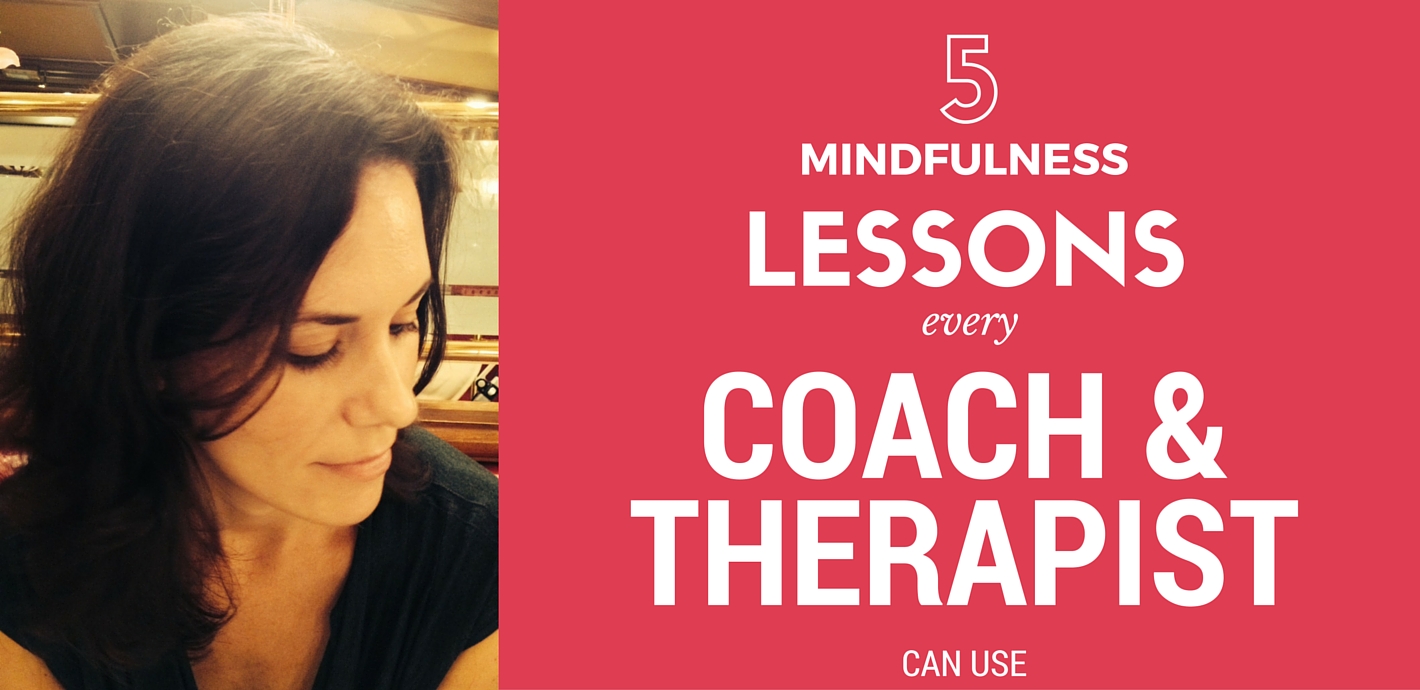Five Mindfulness Lessons Every Coach and Therapist Can Use
October 27, 2016 | 1 Comment
Within the first few nutrition therapy sessions with a new client, I inevitably ask her (or him) to do something that seems impossible: to stay in the icky, fearsome, claustrophobic space between having a painful emotion and automatically reacting to it by overeating.
This might not sound like much, but to someone struggling with emotional overeating, learning to stay with her experience during these crucial moments is momentous work. What makes it so difficult is complex. First of all, eating is a pleasurable alternative to virtually any negative experience, which reinforces the behavior. Secondly, food works – if only temporarily – to soothe, distract from, and discharge a painful emotion. And third, few of us ever really learn to tolerate discomfort, meaning most of us feel incapable of navigating emotional upheaval. We all experience suffering in our lives at times, but for someone who emotionally overeats, even more problems arise when eating becomes the only way to cope with difficulty, and when that behavior brings about its own particular brand of anguish.
As a result of emotional overeating, people experience a range of additional suffering. Even more than the physical pain associated with eating too much is the deteriorating sense of self trust, the declining self esteem, and the way emotional overeating affects everything from work and social interactions, to intimacy with loved ones, to being able to enjoy normal daily activities. In effect, the effects of emotional overeating reach into nearly every corner of their lives. Yet they find themselves repeating the pattern, not knowing how to interrupt its momentum or find the space to try something different.
For people who emotionally overeat, the antidote to this habitual reaction is to learn how to feed their bodies – about 25% of our work – and to train their minds – which comprises about 75% of what we do. We begin by feeding the body regularly and with nourishing food to create physical stability and resilience. Then we move on to working with the mind to cultivate flexibility, tolerance for discomfort, and a sense of non-judgmental curiosity.
How exactly one does this, however, was never a topic of my fairly extensive formal education in nutrition, counseling, or science. In helping my clients approach this seemingly impossible task, the skill set I draw on most is the one I cultivated as a result of my meditation practice.
Not that long ago, I used to react to my own emotional pain by drinking. From an early age, drinking was my preferred dysfunctional coping mechanism. It provided an escape from my insecurities, loneliness, sadness, and anger, but caused physical ramifications and chipped away at my confidence and self worth. Nearly 9 years ago I decided to stop drinking to explore that tender space between pain and reaction. At first I just replaced booze with other things – food, shopping, dating, binge watching TV, you name it – essentially recreating the habitual reaction with a different substance but still not dealing directly with my pain.
I sensed there was something to be learned from the exact thing I was avoiding but I lacked the stability and perspective necessary to stay in that space. Finally I discovered the missing piece: developing the ability to sit with my experience, regardless of whether what arose was good, bad, or ugly. And what allowed me to do that was meditation.
The technique was deceptively simple: I placed my awareness on my breath so that my mind and body were in the same place at the same time. No matter how many times I became distracted, I redirected my attention back to the breath; each time my mind got carried way, I simply started over. At first it was hard to stay present for even one whole breath cycle, but gradually – like strengthening a weak muscle – I was able to maintain that awareness for longer periods. At the same time, an unexpected and multifaceted parade of emotions and thoughts passed through my mind. Some were mundane, like to-do lists and what to eat for lunch. But a lot of them were provocative – joyful, silly, scary, distressing, or sad. And through each of them I learned to keep my seat, continuing to train my mind to come back to the present moment. Again and again and again.
What I experienced on the cushion – learning that I could stay present despite internal turmoil – was in and of itself worth the effort. But what I didn’t anticipate were the effects my meditation practice would have on my personal and professional life off the cushion. Those potent effects form the basis of my practice as a nutrition therapist and are in fact why I can be of benefit to my clients:
- Presence – From the moment a client makes the first contact with me, I begin to establish trust by being calm, paying attention, and listening carefully. Clients sense that I am able to hold the space with them, no matter what arises, and in turn they learn to hold the space for themselves. This ability to “show up” for one another allows our work to unfold in an authentic way.
- Compassion – Just as my meditation instructor served as the voice of sanity I now hear in my own head, I can do that for my clients. By modeling gentleness, empathy, and compassion, self-aggressive individuals are able to soften toward themselves and their experience. Our compassion for one another also fosters a sense of connectedness, and shows us how much we have to learn from one another.
- Patience – In helping people unlearn long-held and painful beliefs and behaviors, it is necessary to slow things down, cultivate mindfulness, and get more comfortable with uncertainty. By meeting my clients where they are rather than forcing my own agenda, I can help them to discover things about themselves at the right pace.
- Flexibility – Whenever we are working toward true change, fear and uncertainty can be paralyzing. Which is why it is so important to approach things with a light touch, a sense of experimentation, and perhaps most importantly a sense of humor. When our experience feels a little less heavy, it becomes easier to pivot and discern what is really needed in any given moment.
- Resilience – Presence, compassion, patience, and flexibility all contribute to an ability to be resilient. Gradually expanding our ability to tolerate discomfort and uncertainty allows us to see ourselves more clearly. As we are experiencing painful emotions, we can skillfully respond in nurturing and loving ways rather than reacting in habitual and damaging ways.
After years of formal education, it is in fact the work that I have done, and continue to do, on (and off) my meditation cushion that allows me to be of benefit to my clients. By creating and nurturing a meditation practice that cultivates presence, patience, compassion, flexibility, and resilience, I am able to help my clients do the same.
 Jenna Hollenstein, MS, RD, CDN, is a writer, nutrition therapist, mindfulness teacher and Open Heart Project Meditation Guide. She will be co-teaching the NEW “How to Become a Meditation Instructor” certified E-Course program with Susan Piver.
Jenna Hollenstein, MS, RD, CDN, is a writer, nutrition therapist, mindfulness teacher and Open Heart Project Meditation Guide. She will be co-teaching the NEW “How to Become a Meditation Instructor” certified E-Course program with Susan Piver.
To learn more about our Meditation Instructor Certification E-Course please go here.
categorized in: meditation, open heart project
We have so much to share with you
Get a new meditation from me every Monday morning